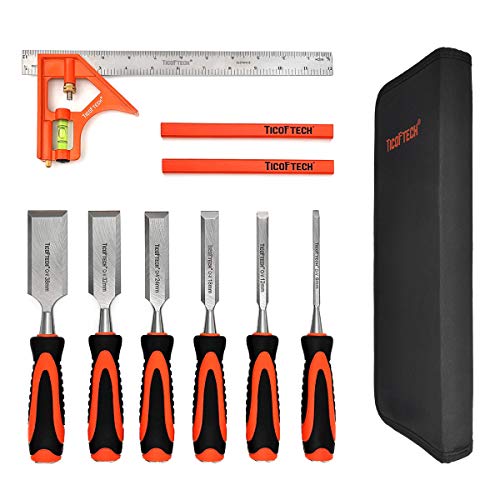Understanding the Measurement of a Drill Press

When it comes to using a drill press, understanding and correctly measuring the various parts and dimensions is essential. A drill press is a powerful tool used to bore holes into various materials, including wood, metal, and plastic. It consists of several components, each with their own measurements that contribute to the overall functionality and precision of the drill press.
One of the key measurements to consider is the drill press’s throat depth. This refers to the distance between the center of the spindle (where the drill bit attaches) and the front of the column (the vertical support structure). The throat depth determines the maximum distance a hole can be drilled from the edge of a workpiece. It is a crucial measurement to consider when working on larger workpieces or when drilling holes near the edges.
The spindle travel is another important measurement to understand. It refers to the vertical movement of the spindle, which determines the maximum depth the drill bit can penetrate into the workpiece. It is measured from the highest point the spindle can reach to its lowest point. The spindle travel is essential to consider when drilling deep holes or when working with varying material thicknesses.
Lastly, the table size is a measurement worth noting. The table is the flat surface that supports the workpiece during drilling operations. It is important that the table is large enough to accommodate the size of the workpiece, providing stability and proper positioning. The table size is typically measured in width and length dimensions and should be considered based on the intended application and size of the materials you will be working with.
The Importance of Measurement in a Drill Press
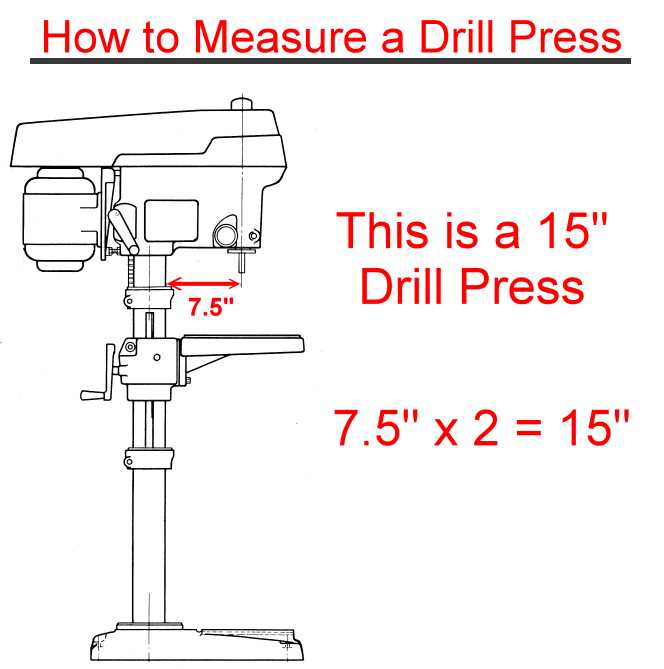
Precision and Accuracy
In a drill press, measurement plays a crucial role in ensuring precision and accuracy in drilling operations. The precise measurement of drill depths, hole diameters, and distances between holes is essential for achieving the desired results and for ensuring that the drilled holes are properly aligned.
A drill press is equipped with various measurement scales, such as a depth gauge, a spindle travel indicator, and a table positioning guide. These measurement indicators allow the operator to accurately set the drilling depth, position the workpiece correctly, and align multiple holes with the desired spacing.
By following the measurement indicators and using them to set up the drill press correctly, an operator can achieve consistent and accurate results with every drilling operation. This is especially important in tasks that require precision, such as drilling holes for dowels, creating mortises for joinery, or installing hardware with specific hole patterns.
Safety
Another important aspect of measurement in a drill press is safety. Properly measuring and positioning the workpiece helps to prevent accidents and ensure that the drill bit does not deviate from the intended path.
For example, by using the depth gauge to set the drilling depth, an operator can avoid drilling too deep and potentially damaging the workpiece or drill bit. Similarly, using the table positioning guide helps to maintain a secure and stable position of the workpiece, reducing the risk of it slipping or shifting during drilling.
Accurate measurement also ensures that the drill bit is correctly aligned with the desired drilling location. This prevents the bit from wandering or drifting off course, which can lead to damage to the workpiece or cause the drill bit to break. By properly measuring and aligning the workpiece, the operator can minimize these risks and ensure a safe drilling operation.
Measurement is also important for achieving efficiency and productivity in drill press operations. By accurately measuring the drilling depth, a drill press operator can avoid wasting time by making unnecessary adjustments or drilling too shallow.
Furthermore, precise measurement enables the operator to plan and execute drilling operations more effectively. By knowing the exact measurements and distances required, the operator can optimize drill bit changes, workpiece repositioning, and hole alignment, minimizing downtime and maximizing productivity.
Overall, measurement plays a crucial role in a drill press by ensuring precision, accuracy, safety, and efficiency. By following measurement indicators and using them to set up the drill press correctly, operators can achieve consistent results, minimize risks, and maximize productivity in drilling operations.
Understanding the Key Measurements
When it comes to drill presses, there are several key measurements that you need to understand in order to make the most out of your tool. These measurements include the following:
1. Swing
The swing of a drill press refers to the distance from the center of the spindle to the front edge of the column. This measurement determines the maximum diameter of the workpiece that can be accommodated by the drill press. It is important to choose a drill press with a swing that is suitable for your specific needs.
2. Throat depth
The throat depth of a drill press refers to the distance from the center of the spindle to the front edge of the column, measured perpendicular to the spindle axis. This measurement determines how far away from the edge of a workpiece you can drill. It is crucial to consider the throat depth when working on larger workpieces or when drilling holes close to the edge.
3. Spindle travel
The spindle travel of a drill press refers to the distance that the spindle can move up and down. This measurement determines the maximum depth of the holes that can be drilled. It is important to choose a drill press with a spindle travel that meets your drilling needs.
4. Table size
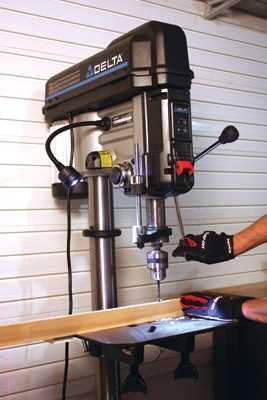
The table size of a drill press is the dimensions of the working surface of the table. This measurement determines the amount of workspace available for positioning and securing the workpiece. It is important to choose a drill press with a table size that can accommodate your workpiece dimensions.
5. Motor power
The motor power of a drill press refers to the amount of power that the motor can generate. This measurement determines the drilling capacity and performance of the drill press. It is important to choose a drill press with a motor power that is suitable for the materials and sizes of the holes you plan to drill.
6. Speed settings
The speed settings of a drill press refer to the different rotational speeds that the drill press can operate at. This measurement determines the versatility and flexibility of the drill press. It is important to choose a drill press with speed settings that can accommodate the specific materials and hole sizes you plan to work with.
7. Chuck size
The chuck size of a drill press refers to the maximum diameter of the drill bit that the chuck can accommodate. This measurement determines the range of drill bit sizes that can be used with the drill press. It is important to choose a drill press with a chuck size that can accommodate the drill bits you plan to use.
By understanding these key measurements, you will be able to choose and utilize a drill press that best fits your specific needs and requirements.
How to Measure the Depth Capacity
To accurately measure the depth capacity of a drill press, follow these steps:
- Securely fasten the depth stop rod into the drill press spindle.
- Lower the drill bit until it makes contact with the base plate or work surface.
- Using a ruler or tape measure, measure the distance between the depth stop rod and the base plate or work surface. This measurement represents the maximum depth capacity of the drill press.
It is important to ensure that the measurement is taken while the drill press is in its lowest position and the depth stop rod is securely fastened. This will provide an accurate representation of the drill press’s depth capacity.
Manufacturers will often provide the depth capacity measurement in the specifications of the drill press. However, it is recommended to measure it yourself to confirm the accuracy of the manufacturer’s claim.
Knowing the depth capacity of a drill press is crucial for selecting the correct drill bit length and for accurately drilling holes to the desired depth. By following these simple steps, you can easily measure the depth capacity of your drill press.
Measuring the Motor Power of a Drill Press
Introduction
In order to determine the motor power of a drill press, it is important to understand how it is measured. The motor power of a drill press refers to the amount of power that the motor can produce, which is usually measured in horsepower (HP) or watts (W).
Power rating
The power rating of a drill press motor can typically be found on the manufacturer’s label or in the product specifications. It is important to note that the power rating represents the maximum power that the motor can produce, and it may not be the actual power output during operation.
HP and W ratings
The motor power of a drill press is usually expressed in either horsepower (HP) or watts (W). Horsepower is a unit of power commonly used in the United States, while watts is the international standard unit for power measurement. It is essential to understand the conversion between these two units to compare motor powers accurately.
1 horsepower (HP) is equivalent to approximately 745.7 watts (W). Therefore, if a drill press has a power rating of 1 HP, it would be approximately 745.7 watts.
Importance of motor power
The motor power of a drill press is a crucial specification that can affect the performance and capabilities of the machine. A higher motor power allows for more torque and faster drilling speeds. This is particularly important when drilling through tough materials or when handling larger workpieces.
Motor power requirements
When choosing a drill press, it is essential to consider the power requirements of the tasks you will be performing. Smaller projects and lighter materials may only require a drill press with lower motor power, while heavier-duty tasks may necessitate a higher-powered machine.
Conclusion
Measuring the motor power of a drill press and understanding its significance is crucial for selecting the right tool for your needs. By considering the power rating and comparing it to the tasks you will be performing, you can ensure that you choose a drill press that will deliver the power necessary to complete your projects effectively and efficiently.
The Importance of Measuring the Spindle Speed
When using a drill press, one of the most important measurements to consider is the spindle speed. The spindle speed refers to the rotation speed of the drill bit or cutting tool attached to the machine. Measuring and setting the spindle speed correctly is crucial for achieving optimal drilling performance and ensuring safety in the workplace.
Accuracy and Precision
Accurate and precise measurements of the spindle speed are critical because they directly affect the quality and efficiency of drilling operations. Different materials and drill bit sizes require specific spindle speeds to ensure optimum drilling results. If the spindle speed is too high, it can cause damage to the workpiece or the cutting tool. Conversely, if the spindle speed is too low, it can lead to inefficient cutting and drilling.
Moreover, incorrect spindle speed can result in poor surface finish, increased tool wear, and decreased productivity. Therefore, accurately measuring and adjusting the spindle speed according to the drilling requirements and the specific properties of the material being worked on is essential for achieving desired drilling outcomes.
Safety Considerations
Measuring the spindle speed is also vital for ensuring a safe working environment. High-speed rotation can generate significant heat and vibration. If the spindle speed is not properly set, it may cause the cutting tool to slip or fail, resulting in accidents and injuries. Additionally, excessive speed can cause the workpiece to become unstable, leading to uncontrolled movement and potential operator harm.
By accurately measuring the spindle speed, operators can set appropriate speed limits that align with the capabilities of the drill press and the specific drilling task at hand. This helps minimize the risk of accidents and enhances overall workplace safety.
Methods of Measuring Spindle Speed
There are several methods for measuring the spindle speed of a drill press. One common method is to use a tachometer, which is a handheld device that measures rotational speed. The tachometer is placed in close proximity to the rotating spindle or drill bit, and the speed is displayed on a digital or analog screen.
Another method is to refer to the drill press’s user manual, which typically provides a chart or table indicating recommended spindle speeds for various drill bit sizes and material types. This method is suitable for operators who do not require precise speed measurements and prefer following standard guidelines.
Conclusion
Measuring the spindle speed is crucial for achieving accurate drilling results, ensuring safety, and maximizing productivity. By understanding and following the recommended spindle speed for the specific drilling task, operators can optimize their workflow and minimize the risk of accidents or damage to the workpiece and cutting tools.
Understanding and Measuring Quill Travel
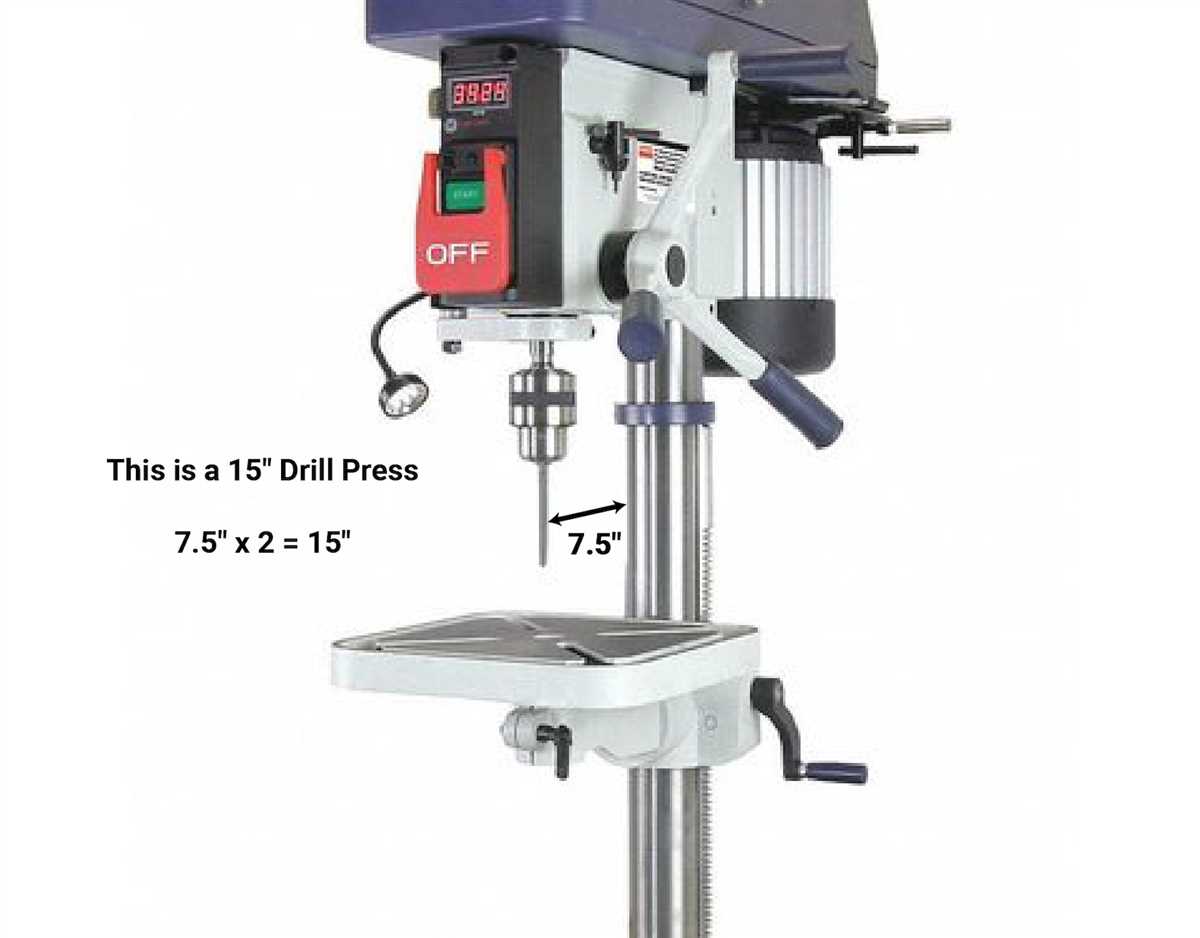
The quill of a drill press refers to the mechanism that allows the drill bit to move up and down. Quill travel, or vertical travel, is an important measurement to consider when choosing a drill press, as it determines the maximum depth at which you can drill into a workpiece. Understanding and measuring quill travel is crucial for ensuring that the drill press you choose is suitable for your needs.
What is Quill Travel?
Quill travel is the distance the quill can travel vertically, from its highest position to its lowest position. It is usually measured in inches or millimeters and is an indication of the maximum depth the drill bit can reach while mounted in the drill press.
How to Measure Quill Travel
To measure the quill travel of a drill press, you will need a ruler, measuring tape, or a caliper. Follow these steps:
- Ensure the drill press is turned off and unplugged.
- Lower the quill to its lowest position.
- Place the ruler or measuring device next to the quill and align it with the lowest point.
- Read the measurement at the highest point of the quill.
This measurement indicates the quill travel of the drill press.
Importance of Quill Travel
Quill travel is essential to consider when selecting a drill press for a specific project. It determines the maximum depth you can drill into a workpiece. If you need to drill deep holes or work with thick materials, a drill press with a larger quill travel would be more suitable.
Knowing the quill travel allows you to plan and execute your drilling operations more effectively, ensuring that you can achieve the desired hole depth without any limitations.
Factors Affecting Quill Travel
The quill travel of a drill press can be influenced by several factors, including:
- Design and construction of the drill press
- Manufacturer specifications
- Size and weight capacity of the drill press
It is important to consult the manufacturer’s specifications or product documentation to accurately determine the quill travel of a particular drill press model.
Measuring Swing Capacity in a Drill Press
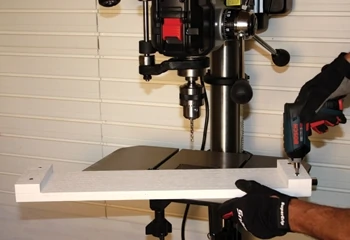
When it comes to choosing a drill press, one of the important factors to consider is its swing capacity. The swing capacity of a drill press refers to the distance between the center of the chuck and the column, multiplied by two. This measurement determines the largest diameter workpiece that the drill press can accommodate.
Why is Swing Capacity Important?
The swing capacity of a drill press is an important specification to consider because it directly affects the size of workpieces that can be drilled. If you frequently work with larger pieces, you will need a drill press with a larger swing capacity to accommodate them. On the other hand, if you mostly work with smaller pieces, a drill press with a smaller swing capacity may be sufficient.
Measuring Swing Capacity
Measuring the swing capacity of a drill press is a simple process. Here are the steps to follow:
- Place one end of a measuring tape at the center of the chuck.
- Extend the tape to reach the column of the drill press.
- Record the measurement.
- Multiply the measurement by two, as the swing capacity is the distance between the chuck and the column multiplied by two.
For example, if the measurement from the chuck to the column is 10 inches, the swing capacity of the drill press would be 20 inches.
Understanding Swing Capacity Limits
It’s important to note that the swing capacity of a drill press indicates the maximum diameter workpiece that can be accommodated, not the maximum height. The height of the workpiece that can be drilled is determined by the vertical clearance between the table and the drill chuck, as well as the maximum stroke length of the drill press.
Additionally, keep in mind that the swing capacity is not the same as the drilling capacity. The drilling capacity determines the maximum hole diameter that the drill press can handle, while the swing capacity determines the size of the overall workpiece that can be accommodated.
Conclusion
Understanding the swing capacity of a drill press is essential for selecting the right tool for your specific needs. By measuring the swing capacity and considering the size of the workpieces you typically work with, you can ensure that you choose a drill press that will meet your requirements.
Measuring the Table Size and Tilt
When it comes to understanding the measurement of a drill press, one important aspect to consider is the table size and tilt. The size of the table determines the amount of working area available for your projects, while the tilt feature allows you to adjust the table’s angle for angled drilling.
Measuring the Table Size
To measure the table size, you will need a tape measure or a ruler. Start by locating the edges of the table and then measure the distance between them. This will give you the length and width of the table. Make sure to measure both dimensions accurately to ensure an accurate assessment of the table size.
It’s also important to consider the depth of the table, as this will determine how far a drill bit can penetrate the workpiece. Measure the distance from the top of the table to the bottom to get an idea of the maximum depth you can drill.
Measuring the Table Tilt
To measure the table tilt, you will need to determine the range of angles that the table can be adjusted to. This information is usually provided by the manufacturer in the drill press specifications. Look for the maximum and minimum angles that the table can be tilted to.
To tilt the table, loosen the table lock and adjust it to the desired angle. Once you have set the table at the desired angle, tighten the table lock to secure it in place. Use a protractor or an angle measuring tool to measure the angle precisely if needed.
Remember that the table tilt feature is especially useful for drilling angled holes or for performing tasks such as drilling on a bevel.
By understanding the measurement of your drill press’s table size and tilt, you can ensure that it meets your needs for various projects and drilling tasks. Whether you need a large table for working on larger pieces or a tilt feature for angled drilling, knowing these measurements can help you make an informed decision when purchasing a drill press.
Understanding the Measurement of the Drill Press Column
The drill press column is an important component of the drill press that determines its overall height and provides support for the drilling operation. It is essential to understand the measurement of the drill press column for various reasons, such as selecting the right size for your specific needs or troubleshooting any issues that may arise during use.
Column Height
The measurement of the drill press column typically refers to its height, which is the distance from the base of the machine to the top of the column. This measurement is crucial because it determines the maximum depth of a hole that can be drilled using the drill press.
When selecting a drill press, it is important to consider the column height based on the projects you plan to work on. If you primarily work with smaller materials, a shorter column height may be sufficient. However, if you frequently work with larger materials or need to drill deep holes, a taller column height will be necessary.
Adjustability
In some drill presses, the column height is fixed, meaning it cannot be adjusted. However, many modern drill presses feature an adjustable column that can be raised or lowered to accommodate different workpieces.
Having an adjustable column provides greater flexibility and allows you to match the height of the drill press to the specific task at hand. It is crucial to understand the range of adjustability and any limitations that may exist. This information can typically be found in the drill press’s specifications or user manual.
Column Material and Construction
The measurement of the drill press column does not solely refer to its height but also encompasses its material and construction. The column is typically made of cast iron or steel, which provides strength and stability to the drill press.
The column may have different diameters and shapes, such as round or square. These variations may affect the overall stability and rigidity of the drill press. Thicker and larger columns tend to be more rigid, reducing vibrations during operation and improving drilling accuracy.
Measuring the Column Height
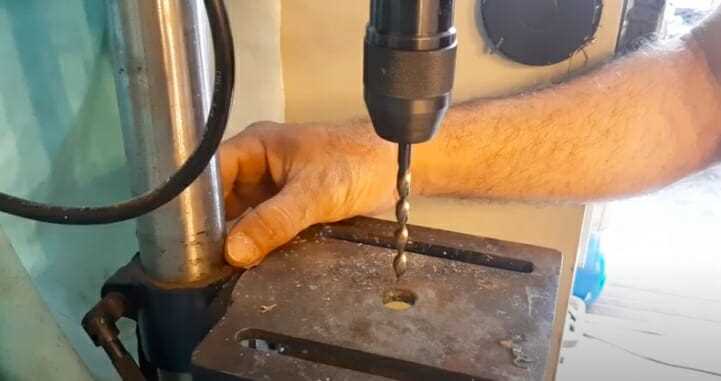
To measure the column height of a drill press, you can use a measuring tape or ruler. Start at the base of the drill press and extend the measuring tool vertically until you reach the top of the column. Take note of the measurement in inches or centimeters.
It is crucial to measure the column height accurately to ensure it aligns with your specific needs or requirements. If you are unsure about the measurement, consult the drill press manufacturer’s documentation or contact their customer support for assistance.
Conclusion
The measurement of the drill press column is an essential aspect to consider when selecting or using a drill press. Understanding the column height, adjustability, material, and construction can help you make informed decisions and ensure optimal performance in your drilling operations.
FAQ:
What is a drill press?
A drill press is a stationary power tool that is used to drill holes in various materials.
What are the main parts of a drill press?
The main parts of a drill press include the base, column, table, spindle, chuck, and motor.
What is the purpose of the column in a drill press?
The column in a drill press provides vertical support and stability to the machine.
How is the speed of a drill press measured?
The speed of a drill press is typically measured in rotations per minute (RPM).
What factors affect the speed of a drill press?
The speed of a drill press can be affected by factors such as the material being drilled, the size of the drill bit, and the type of cutting operation being performed.
Video:





![[(Understanding Maths: Geometry & Measurement)] [By (author) Hilary Koll ] published on (January, 2015)](https://m.media-amazon.com/images/I/41wFR6HeA+L._SS520_.jpg)







